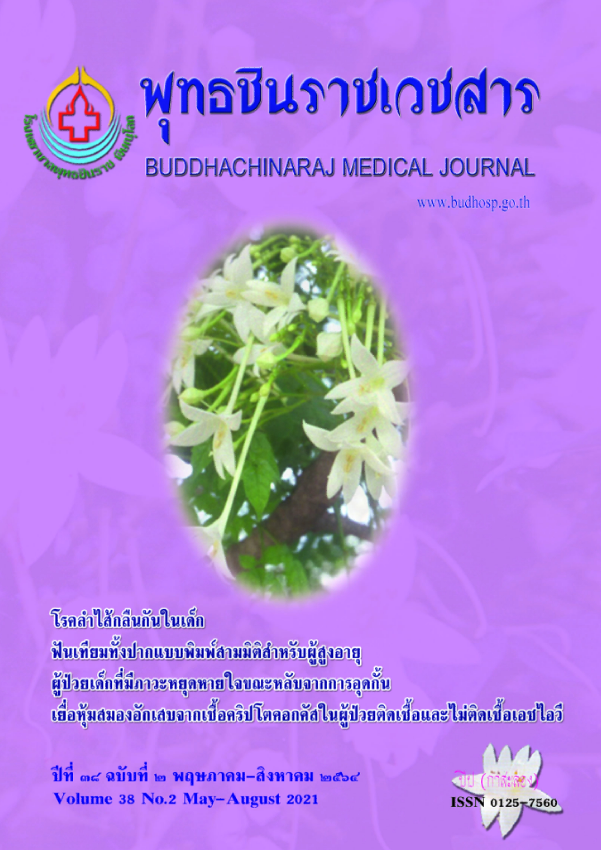ผลลัพธ์ทางคลินิกของโรคลำไส้กลืนกันในเด็กระหว่างผู้ป่วยที่ได้รับการวินิจฉัย ภายในและหลัง 24 ชั่วโมงหลังมีอาการ
โรคลำไส้กลืนกันในเด็ก
คำสำคัญ:
ลำไส้กลืนกัน, แรงดันผ่านทางทวารหนัก, การผ่าตัดเพื่อใช้มือดันคลายการกลืนของลำไส้บทคัดย่อ
โรคลำไส้กลืนกันเป็นสาเหตุที่พบบ่อยที่สุดของภาวะลำไส้อุดตันเฉียบพลันในเด็กอายุน้อยกว่า 2 ปี การวินิจฉัยที่ถูกต้องและรวดเร็วช่วยในการตัดสินใจเลือกวิธีรักษา ลดภาวะแทรกซ้อน และระยะเวลานอนโรงพยาบาลการศึกษาแบบวิเคราะห์นี้มีวัตถุประสงค์เพื่อเปรียบเทียบผลลัพธ์ทางคลินิก ของผู้ป่วยเด็กโรคลำไส้กลืนกันระหว่างผู้ป่วยที่ได้รับการวินิจฉัยภายในและหลัง 24 ชั่วโมงหลังมีอาการ โดยศึกษาข้อมูลย้อนหลังจากเวชระเบียนผู้ป่วยในของเด็กอายุน้อยกว่า 15 ปีที่ได้รับการวินิจฉัยเป็นโรคลำไส้กลืนกันและเข้ารับการรักษาในโรงพยาบาลพุทธชินราช พิษณุโลก ระหว่าง เดือนมกราคม พ.ศ. 2550 ถึงเดือนธันวาคม พ.ศ. 2563 พบผู้ป่วยทั้งหมด 183 คน เป็นกลุ่มที่ได้รับการวินิจฉัยภายใน 24 ชั่วโมง 107 คน (ร้อยละ 58.5) และหลัง 24 ชั่วโมง 76 คน (ร้อยละ 41.5) กลุ่มที่ได้รับการวินิจฉัยภายใน 24 ชั่วโมงถ่ายอุจจาระเป็นมูกเลือดมากกว่า แต่ท้องอืดและท้อง เสียน้อยกว่าอีกกลุ่มอย่างมีนัยสำคัญทางสถิติ ทั้ง 2 กลุ่มได้รับการตรวจวินิจฉัยและการรักษาไม่แตกต่างกัน แต่กลุ่มที่ได้รับการวินิจฉัยหลัง 24 ชั่วโมง มีจำนวนวันนอนโรงพยาบาลนานกว่า เกิดภาวะแทรกซ้อนและลำไส้ทะลุมากกว่าอีกกลุ่ม 2.94 และ 6 เท่าตามลำดับอย่างมีนัยสำคัญทางสถิติ สรุปได้ว่ากลุ่มที่ได้รับการวินิจฉัยหลัง 24 ชั่วโมงมีระยะเวลานอนโรงพยาบาล ภาวะแทรกซ้อนและลำไส้ทะลุมากกว่ากลุ่มที่ได้รับการวินิจฉัยภายใน 24 ชั่วโมง
เอกสารอ้างอิง
2. Bines JE, Liem NT, Justice FA, Son TN, Kirkwood CD, de Campo M. Intussusception Study Group. Risk factors for intussusception in infants in Vietnam and Australia: adenovirus implicated but not rotavirus. J Pediatr 2006;149(4):452-60.
3. Khumjui C, Doungntern P, Sermgew T, Smitsuwan P, Jiraphongsa C. Incidence of intussusception among children 0-5 years of age in Thailand, 2001-2006. Vaccine 2009;27(Suppl 5):116-9.
4. World Health Organization. Acute intussusception in infants and children. Incidence, clinical presentation and management: a global perspective. Geneva, Switzerland:World Health Organization; 2002. p.1-98.
5. Liu N, Yen C, Huang T, Cui P, Tete JE, Jiang B, et al. Incidence and epidemiology of intussusception among children under 2 years of age in Chenzhou and Kaifeng, China, 2009-2013. Vaccine 2018;36(51):7862-7.
6. Jiang J, Jiang B, Parashar U, Nguyen T, Bines J, Patel MM. Childhood Intussusception: a literature review. PLOS ONE 2013;8(7):e68482. https://doi.org/10.1371/journal.pone.0068482
7. Samad L, Cortina-Borja M, Bashir HEI, Sutcliffe AG, Marven S, Cameron JC, et al. Intussusception incidence among infants in the UK and Republic of Ireland: a pre-rotavirus vaccine prospective surveillance study. Vaccine 2003;31(38):4098-102.
8. Erkan N, Haciyanli M, Yildirim M, Sayhan H, Vardar E, Polat AF. Intussusception in adults: an unusual and challenging condition for surgeons. Int J Colorectal Dis 2005;20(5):452-6.
9. Mandeville K, Chien M, Willyerd FA, Mandell G, Hostetler MA, Bulloch B. Intussusception: clinical presentations and imaging characteristics. Pediatr Emerg Care 2012;28(9):842-4.
10. Harrington L, Connolly B, Hu X, Wesson DE, Babyn S, Schuh S. Ultrasonographic and clinical predictors of intussusception. J Pediatr 1998;132(5):836-9.
11. Lai AH, Phua KB, Teo EL, Jacobsen AS. Intussusception: a three years review. Ann Acad Med Singap 2002;31(1):81-5.
12. Losek JD, Fiete RL. Intussusception and the diagnostic value of testing stool for occult blood. Am J Emerg Med 1991;9(1):1-3.
13. Nasir AA, Nwosu D, Bamigbola KT, Abdur-Rahman LO, Obiora MA, Gobir AA, et al. Economics and clinical implications of delayed presentation of children with intussusceptions: minimizing healthcare cost in the context of limited resources. Egypt J Surg 2018;37(4):600-5.
14. Ko HS, Schenk JP, Troger J, Rohrschneider WK. Current radiological management of intussusception in children. Eur Radiol 2007;17(9):2411-21.
15. Carroll AG, Kavanagh RG, Ni Leidhin C, Cullinan NM, Lavelle LP, Malone DE. Comparative effectiveness of imaging modalities for the diagnosis and treatment of intussusception: a critically appraised topic. Acad Radiol 2017;24(5):521-9.
16. Ullah N, Irshad M, Ullah I, Khan MI, Hayat M, Hussain M. Ultrasound guided hydrostatic reduction of intussusception in children with late presentation. Khyber Med Univ J 2019;11(1):37-40.
17. Maqbool A, Liacouras C. Intussusception. In: Kliegman RM, ST Geme J, Blum N, Shah S, Tasker R, Wilson K, editors. Nelson Textbook of Pediatrics. 21st ed. California City, California State, USA: Elsevier; 2020.p.7807-16.
18. Lehnert T, Sorge I, Till H, Rolle U. Intussusception in children-clinical presentation, diagnosis and management. Int J Colorectal Dis 2009;24(10):1187-92.
19. Tareen F, Ryan S, Avanzini S, Pena V, Laughlin DM, Puri P. Does the length of the history influence the outcome of pneumatic reduction of intussusception in children?. Pediatr Surg Int 2011;27(6):587-9.
20. Charles T, Penninga L, Reurings JC, Berry MCJ. Intussusception in children: a clinical review. Acta Chir Belg 2015;115(5):327-33.
21. Saxena AK, Hollwarth ME. Factors influencing management and comparison of outcomes in paediatric intussusceptions. Acta Paediatr 2007;96(8):1199-202.
22. Wiersma F, Allema JH, Holscher HC. Ileoileal intussusception in children: ultrasonographic differentiation from ileocolic intussusception. Pediatr Radiol 2006;36(11):1177-81.
23. Samad L, Marven S, Bashir HEI, Sutcliffe AG, Cameron JC, Lynn R, et al. Prospective surveillance study of the management of intussusception in the UK and Irish infants. Br J Surg 2012;99(3):411-5.
24. Morrison J, Lucas N, Gravel J. The role of abdominal radiography in the diagnosis of intussusception when interpreted by pediatric emergency physicians. J Pediatr 2009;155(4):556-9.
25. Tareen F, McLaughlin D, Cianci F, Hoare SM, Sweeney B, Mortell A, et al. Abdominal radiography is not necessary in children with intussusception. Pediatr Surg Int 2016;32(1):89-92.
26. Ramachandran P, Gupta A, Vincent P, Sridharan S. Air enema for intussusception: is predicting the outcome important?. Pediatr Surg Int 2008;24(3):311-3.
27. Sadigh G, Zou KH, Razavi SA, Khan R, Applegate KE. Meta-analysis of air versus liquid enema for intussusception reduction in children. AJR 2015;205(5):542-9.






